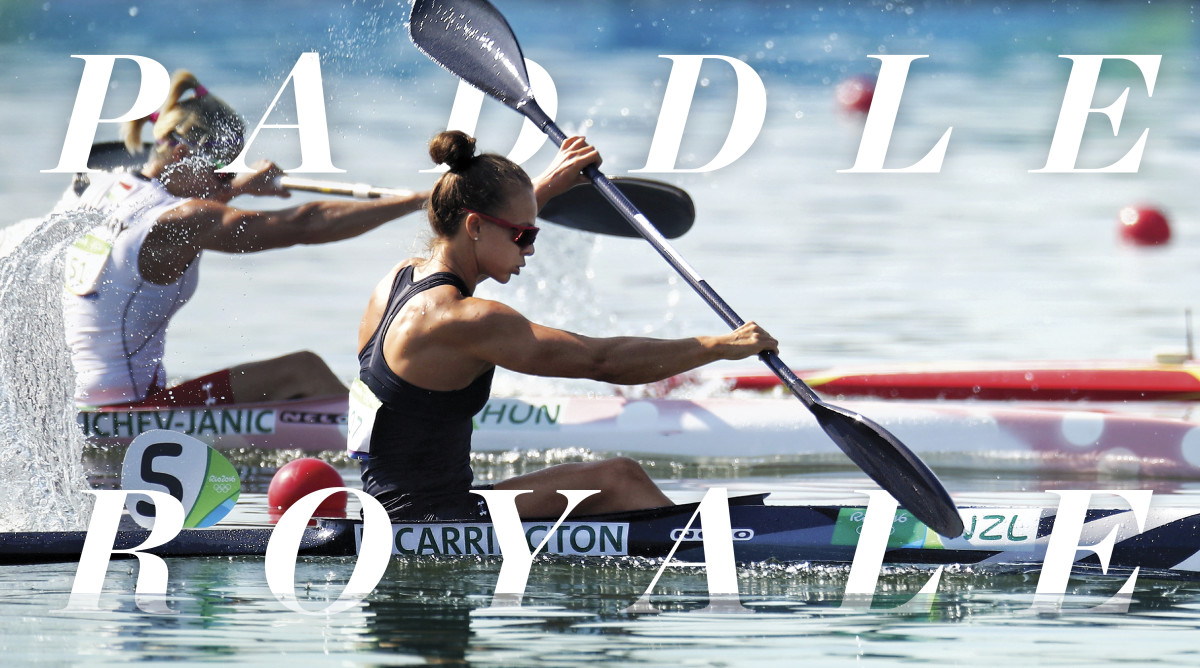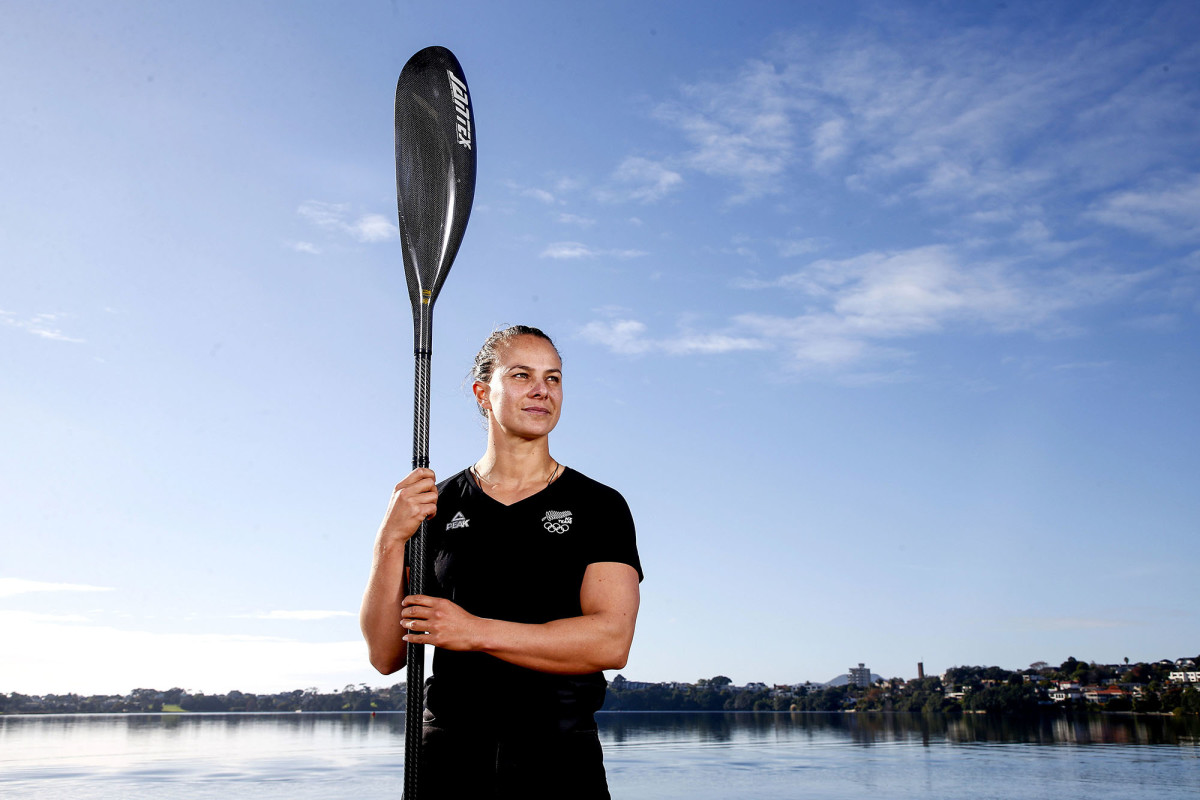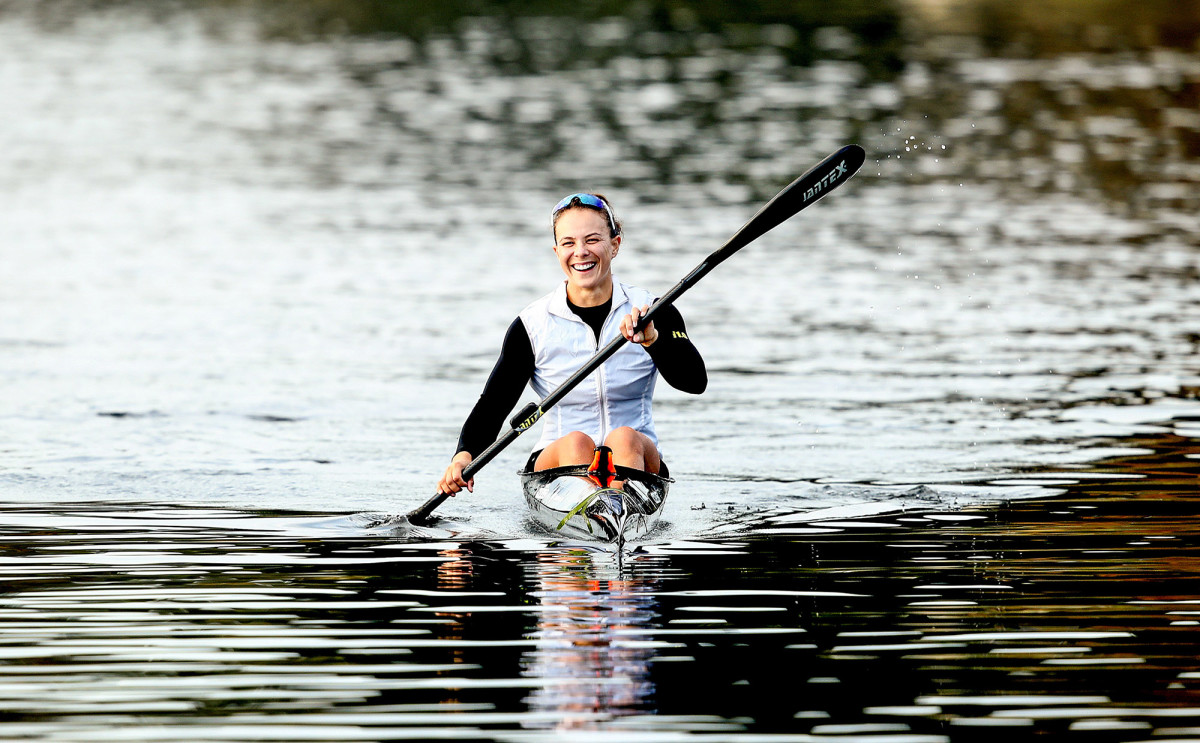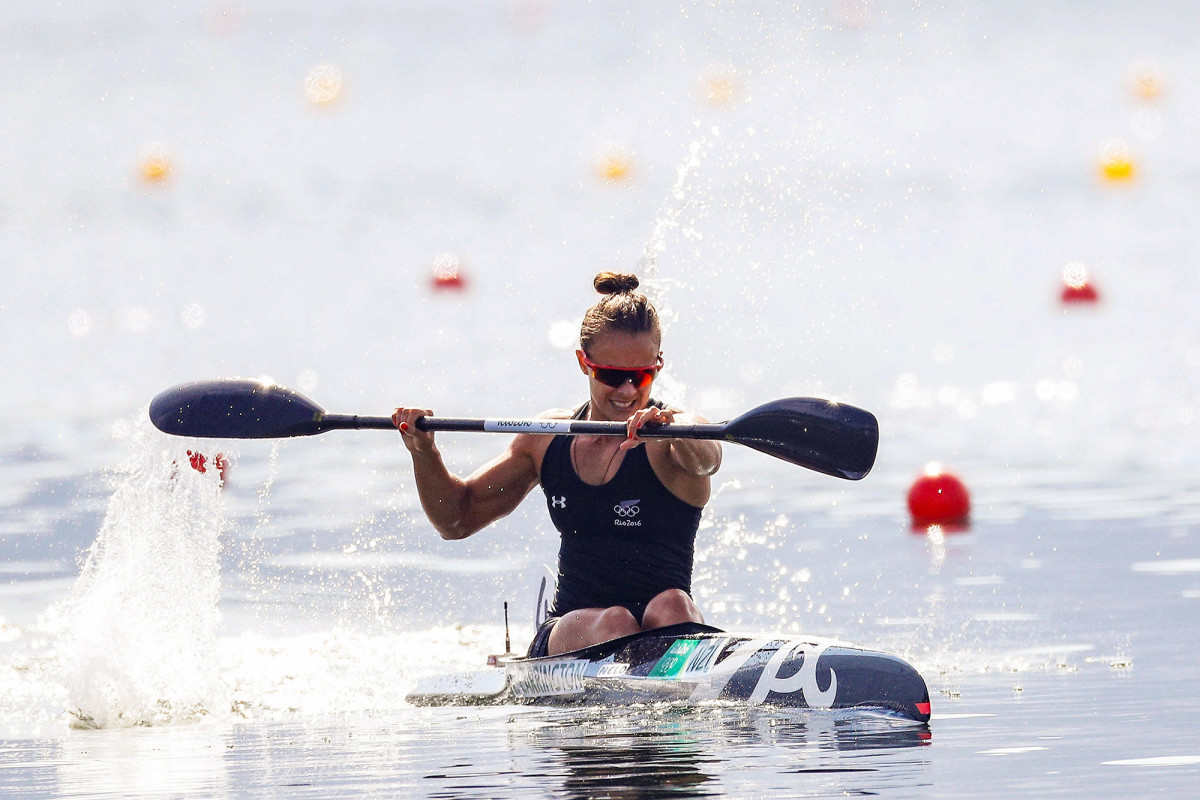Meet Lisa Carrington, the Most Dominant Olympian You've Likely Never Heard Of

Sign up for our free daily Olympics newsletter: Very Olympic Today. You'll catch up on the top stories, smaller events, things you may have missed while you were sleeping and links to the best writing from SI’s reporters on the ground in Tokyo.
Kāore te kūmara e kōrero mō tōna ake reka
(The kūmara doesn't speak of its own sweetness)
—Māori proverb
Lisa Carrington rests her chin in her palm as her eyes drift away from the Zoom screen, lost in thought. She is sitting at a rental house on Australia’s Gold Coast, where the two-time Olympic gold medalist has been busy training with her New Zealand sprint kayak teammates in late June before heading off to the Tokyo Games. She is pondering the following puzzler: Can you recall the last time you didn’t win your signature race, the 200-meter singles?
“Yeah, I think I ...” Carrington, 32, begins, trailing off. “Um … oh … I … Like, in a final?”
Finally the answer dawns. Sure, Carrington has dropped the odd qualifying heat or semifinal in the ensuing nine-plus years, but her last true sub-first showing came in May 2012, at the World Cup in Duisburg, Germany, by a margin of 0.096 seconds. “I remember, just strategically, not doing it super well,” Carrington says now. “I learned a lot from that moment.”
Clearly so. Consider: Since that Duisburg disappointment, Carrington has claimed six consecutive world championships in the 200-meter singles, along with golds in London and Rio—plus two more world titles and a bronze in the 500-meter singles. Tack on a tough annual slate of domestic competition and her current 200-meter singles streak now stands at roughly 50 meets, inspiring at least one comparison to the most dominant Olympian alive, Simone Biles.
Not that Carrington cares. “I guess you don’t want to lose the streak you have, but I purposefully try not to focus on it,” she says. “It doesn’t matter, because my next race matters. Maybe later I’ll have a peaceful moment thinking, ‘Wow, that’s really cool, it’s really special.’ But I’m still striving for the next thing as well. It shouldn't change my process in how I try to keep getting better.”

Quietly humble yet furiously driven, Carrington adheres to a strict workout regimen on dry land, rising at the same time each morning to stretch, conduct breathing exercises, and write down goals in her journal, according to fiancé Michael Buck. (For their first date, Carrington arrived some 45 minutes late because she had gotten held up in training. “I just remember feeling stoked that I hadn't actually been stood up,” Buck says.) In the gym she impresses teammates with her flying chin-ups, flinging herself high over the bar before catching it on the way back down, and begrudgingly boasts a nickname befitting her bulging biceps: Golden Guns. “I think at first she wasn't a fan,” Buck says. “She's come to accept it.”
On the water, Carrington taps her superior strength to surge ahead of opponents, cruising to easy victories by whole boat lengths, such as when she obliterated the 200-meter singles field by nearly two seconds at the 2019 world championships. “In recent times, she's really only been racing herself,” her coach, Gordon Walker, says. “And often it's hard to contextualize that, because it's like, ‘Did I win by enough? What does it really mean?’ ”
But she also must balance such power with finesse and, well, balance. Think about a duck—serene above the surface, feet churning out of sight. At her best, Carrington takes the opposite approach. Her arms pump like windmills on hyperdrive, while her legs must remain controlled enough to keep the boat from straying off course. “The boats we paddle in are really unstable,” Carrington says. “You can be really strong in the gym, when you’re stable and controlled, but applying it on the water can be really tricky. You have to have skill as well.”
It all adds up to an odds-defying story that has positioned Carrington to make even more history in Tokyo, where she is scheduled to compete in a grueling four-event slate—in addition to the 200- and 500-meter singles, she will paddle in the 500-meter pairs and fours—and needs just three gold medals to become New Zealand’s most decorated Olympian ever.
“It wasn't always obvious that she was going to become the best in the world,” Buck says. “Although, that soon happened.”
While she currently resides in Auckland, the home base of New Zealand’s women’s kayaking team, Carrington grew up a few hours away in Ohope Beach, along the eastern Bay of Plenty. There, a mild climate lent itself to year-round outdoor activities, and Carrington took full advantage from a young age. Netball and tennis were early passions, but “the ocean was her playground,” says her father, Pat. “She had quite a natural feel for water.”
The youngest of three, Carrington often tagged along to the shores with brothers Shaun and Brett, learning to tame the thrashing waves and, later, competing in the multitasking discipline of surf lifesaving. “They would be, as boys, just a lot stronger than her, but she went out there for the same amount of time,” says Carrington’s mother, Glynis. “Not because we or anyone else told her to. It was just that drive to be out there and to practice. She probably trained harder as a young one than what we’d ever expect anyone to do, just because she wanted to.”
The hard work paid off when, at 16, Carrington won a national race in surfski, a kayak-esque vessel used in surf lifesaving. Soon after, intrigued by her paddling potential, Pat signed his daughter up for a kayaking camp on a lake outside Ohope, where one of the coaches happened to be Ian Ferguson, a New Zealand kayaking legend and four-time gold medalist. “She was a natural,” Ferguson has said. “She showed she had the flow from the start.” Later that year, borrowing a fellow racer’s boat, Carrington entered the national championships in Auckland.

Stroke by stroke, Carrington gradually got hooked. At first she kept kayaking simply to maintain her fitness over the winter for surf lifesaving, but before long it had taken over as her top pursuit. There were no clubs to join in Ohope, though, so she continued training by herself, driving to the Whakatane River before dawn each morning and following a workout regimen sent by a coach Pat had gotten to know. Eventually she earned a sponsorship from a local Lions Club, which provided her with a proper racing kayak of her own.
“I think that was another indicator of perhaps the potential she had,” Pat says, “that she could do that well on very little training with no coaching, except for a document that came in the mail.”
In 2007, Carrington was selected to represent New Zealand at the Australian Youth Olympic Festival, and later at the junior world championships in the Czech Republic. The following year, she made the tough decision to forgo attending university and instead relocated to Auckland to begin high-level training six days a week, making ends meet with a pair of barista jobs on the side. “It was not an easy road for her,” Glynis says, but the results were immediate:
In 2008, a coach called in a favor and entered Carrington in a 200-meter singles race at Hungary’s under-23 championships. The nine-lane field was already full by then, though, so Carrington was forced to race in a makeshift 10th lane on the outside, plowing through overhanging willow branches as she steamed down the course. She won anyway, beating, among others, a paddler who had been recently selected to attend the Beijing Olympics.
“I guess that was probably the time we thought, ‘Oh, she's pretty good at this,’ ” Pat says.
She would only get better. After linking up with Walker just past the turn of the decade, Carrington became the first New Zealand woman to earn a gold medal at the world championships, in 2011, completing the 200-meter singles final in a blistering 39.998 seconds.
A year later, as she approached the Olympic start line in London, cameras captured her subtly smiling and briefly sticking out her tongue, Air Jordan style. It was a rare show of emotion for Carrington, but she had embraced it as a tactical way to find the right racing mindset. “It puts that fear aside and gets me to a place where I say, it's all good,” Carrington says.
When Carrington eventually crossed the finish line nearly a half-second ahead of Ukraine’s Inna Osypenko, she not only captured the first women’s 200-meter singles gold in Olympic history—the event debuted in 2012—to go along with her country’s first-ever sprint kayaking gold. She also became the first Māori athlete ever to win Olympic gold, a monumental athletic accomplishment for the historically marginalized and oppressed Indigenous population.
“With New Zealand and its history of colonization, there's a lot behind where we are now, and how New Zealand is set up,” Carrington says. “And I think what's awesome about where we're at, as a country—it's been happening for a while now, but more and more so—people are more accepting of what's happened in the past to Māori, and how important it is to acknowledge. For me, that's really important in what that represents as a high-achieving Māori athlete, being one of many Māori women in New Zealand, to set examples for where people can get to.”
Over time, Carrington says, she has tried to connect on deeper levels with her heritage, whether through meeting community leaders or simply speaking to members of her father’s family. But she also keeps her culture close in other ways. In London, for instance, her singles boat was decorated with commissioned artwork of a taiaha (a Māori spear) running along its broad side and koru (waves) wrapping around the stern. And when she later climbed atop the medal stand, dangling beneath her windbreaker was a pounamu (greenstone) necklace gifted by her parents, the custom design meant to represent courage, bravery, safe travel and whanau (family).
“I guess it’s all about going out there, representing your country, having courage and strength and carrying those people from home with you,” Carrington says.
While Carrington’s dominance no doubt helps her popularity with fellow Māori, her father explains, it’s another attribute that perhaps resonates most. This is where the proverb about the kūmara, a Māori cultivar similar to a sweet potato, comes in. Like the kūmara, Pat says, “She never talks about her strengths and abilities. And that always endears itself to a lot of people.”
After London, where Carrington also finished seventh in the 500-meter pairs, her boat partner, Erin Taylor, retired. So Carrington took aim at adding another individual challenge to her repertoire: the 500-meter singles, a physical and mental marathon compared to its 200-meter counterpart. She also adopted a more aggressive strategy for the 200, working to unleash her full power from the outset rather than waiting to make her move later on in the race.
“My first stroke has to be my hardest stroke, because that's going to get the best outcome and best out of myself,” she says. “That's quite scary—to just go. But that's what I feel: I have to just face that fear and have as much courage as I can to get through that goal.”
As Carrington’s goals grew, so did her fame. She was named the 2012 Māori Sportsperson of the Year, and in 2013 received the New Zealand Order of Merit. A street near her childhood home was renamed Lisa Carrington Lane. When she swept the 200- and 500-meter singles at the 2015 world championships, a trip to greet her parents in the stands ended with a manager whisking her away through a mob of autograph-seeking fans. “That was like, ‘Oh my gosh, she’s actually quite famous,’ ” Glynis says. Later on she received a video from a friend’s young son, who declared that the two fastest people on the planet were Usain Bolt and Lisa Carrington.

Pressure mounted heading into the 2016 Rio Games, manifesting in several “tense” phone calls to Buck from the Olympic Village. “Being a defending champion,” Buck says, “she talked about how difficult that was.” She hardly seemed affected on the water, though, earning bronze in the 500-meter singles and repeating her 200-meter title. She even allowed herself a rare moment of swagger at the end of the latter final, grinning as she wagged a single finger in the air and rang an imaginary victory bell. “It was the dominance that I felt in that moment,” Carrington says.
Since then, Carrington has hardly slowed down. She ramped up her gym training in anticipation of Tokyo, setting a goal of competing in four events there. (“Basically I'm doing it because there's an opportunity, and I can do it,” she says.) A taste of her progress came at the 2019 world championship in Szeged, Hungary, where on successive days she claimed her seventh straight 200-meter singles title—by a massive margin of 1.94 seconds, no less—and then beat the 500-meter singles field by a boat length. “I don't think it was anything special that allowed her to do that,” Buck says. “I think she just made up her mind that she was going to smash it.”
As the calendar flipped to 2020, Carrington was cruising, her focus fixed on Tokyo. “I had got to a point where I had really worked on my race strategy, where I’d managed to get better every year,” she says. “It was like, ‘Yep, striving, nothing can stop me from going to the Olympics.”
Except, of course, the one thing that stopped the Olympics altogether.
Twenty-four hours. That was all Carrington recalls having to prepare for New Zealand’s full-bore, level-four lockdown in the early days of the COVID-19 pandemic in March 2020. Rushing to her high-performance gym in Auckland, she chucked a grocery cart’s worth of barbells and weighted plates into the cockpit of her kayak. “My car was low-riding on the way home,” she recalls. “It was wicked. It was really important just to go, ‘Yep, this is what I need.’ ”
Around the same time, when Carrington first learned that the Tokyo Games had been postponed, her attitude was much different. “I was really annoyed about it,” she says. “Like, ‘Man, I’m so prepared for this. How come I have to stop?’ ” Before long, though, she settled into a refreshingly no-frills routine, pumping out reps on her kayak erg machine and cranking out flying chin-ups on a bar in her garage. Zoom and FaceTime kept her in touch with coaches and training partners, but otherwise she was alone. “Just had to get down to the bare basics,” she says. “That was really great. You don’t need every piece of equipment to get what you need.”
She carved out time for other pursuits, too, baking sourdough bread and getting a Cavoodle puppy named Colin. She also continued her postgraduate studies in psychology, an extension of her “passion for mental health” as an athlete. The level-four lockdown ended after four weeks, clearing Carrington to return to the water, but still it was the longest stretch of a scheduled training period that she had ever gone without paddling. “I just had to find a way to believe in what I was doing and find the purpose,” she says. “I don't think it took anything away from my paddling itself. It almost just gave me a different dimension to support my paddling.”
As with every Olympic athlete, it remains to be seen how the layoff will ultimately affect her performance in Tokyo, where plenty more challenges await. Projected record highs of heat and humidity will be “a massive factor” at Sea Forest Waterway, Carrington says. (Not to mention any potential lingering effects from the course’s oyster invasion earlier this year.) Her schedule figures to be just as blistering, with upwards of 15 races in four events over just six days.

Eclipsing Ferguson as her country’s most decorated Olympian will be a tall order, too: In the 500-meter fours, Germany and Hungary have finished 1–2, in some order, at the past five Games; similarly, paddlers from one of those two countries have earned seven straight golds in the 500-meter pairs, and no non-European has ever won the 500-meter singles.
“It’s gonna be a tricky week,” Carrington says. “But I just have to be really strict and deliberate with everything I do—recovery, warmups, warmdowns—and just find the joy in that challenge as well. It’s gonna be hectic, but I think we're ready for it.”
So, too, is everyone back in Ohope Beach. COVID-19 restrictions have prevented Glynis and Pat from traveling to Tokyo, but they plan to capitalize on the three-hour time difference by hosting viewing parties in the library of Waiotahe Valley School, a small primary institution of about 120 students where both Carrington parents teach.
“We got a big TV,” Pat says. “We’ll pile them all in.”
“And we’ll watch together and cheer,” Glynis says, hoping to smile along with their hometown hero as she streaks from the start line and blows her competition out of the water.
Now that would be sweet.
More Olympics Coverage:
• Former Gymnasts Left Paralyzed Are No Stranger to the Struggles Biles Faced
• Bright Future Ahead for U.S. Swimming After Tokyo
• It's Time to Appreciate the Olympic Legacy of Brittney Reese
• Caeleb Dressel's Picture-Perfect Tokyo Olympics
